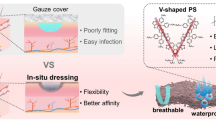Abstract
Purpose. Currently, most pDNA delivery systems based on synthetic polymers are either nonbiodegradable or not sensitive to the release environment. The primary objective of this study was to develop and evaluate an aqueous-based, thermosensitive, biodegradable and biocompatible triblock copolymer to control pDNA delivery in vitro and in vivo.
Methods. The triblock copolymers, poly[ethylene glycol-b-(D, L-lactic acid-co-glycol acid)-b-ethylene glycol] (PEG-PLGA-PEG), were synthesized as previously described. The molecular weight and polydispersity of PEG-PLGA-PEG were monitored by gel permeation chromatography (GPC). The cytotoxicity of PEG-PLGA-PEG was evaluated by 3-(4,5-dimethylthiazol-2-yl)-2,5-diphenyltetra- zolium bromide assay. The release of 32P-labeled pDNA entrapped in aqueous dispersion of PEG-PLGA-PEG in 0.1 mol/L sodium phosphate buffer solution (pH 7.4) was studied at 37°C under agitation. Gene transfection efficiency was evaluated in a skin wound model in CD-1 mice.
Results. The aqueous dispersion of PEG-PLGA-PEG flows freely at room temperature but form a gel at 37°C body temperature. The in vitro degradation of PEG-PLGA-PEG lasted for more than 30 days. The cytotoxicity of PEG-PLGA-PEG evaluated in HEK 293 cells was significantly lower than that of poly-L-lysine hydrochloride. The release profile of supercoiled pDNA from the polymer followed the zero-order kinetics up to 12 days. Maximal gene expression of luciferase was at 24 h in the skin wound of CD-1 mice and by 72 h, the expression dropped by nearly 94%.
Conclusions. These results suggest hydrogel formed by PEG-PLGA-PEG could be a promising platform for delivery of pDNA, which represents a novel strategy that may serve as a non-viral vector for gene therapy in wound healing.
Similar content being viewed by others
References
W. F. Anderson. Human gene therapy. Nature 392:25–30 (1998).
S. Choksakulnimitr, S. Masuda, H. Tokuda, Y. Takakura, and M. Hashida. In vitro cytotoxicity of macromolecules in different cell culture systems. J. Control. Release 34:233(1995).
G. A. Brazeau, S. Attia, S. Poxon, and J. A. Hughes. In vitro myotoxicity of selected cationic macromolecules used in non-viral gene delivery. Pharm. Res. 15:680–684 (1998).
T. W. Atkins, R. L. McCallion, and B. J. Tighe. The incorporation and sustained release of bioactive insulin from a bead-formed macroporous hydrogel matrix. J. Biomed. Mater. Res 29:291–298 (1995).
T. C. Holmes, S. de Lacalle, X. Su, G. Liu, A. Rich, and S. Zhang. Extensive neurite outgrowth and active synapse formation on self-assembling peptide scaffolds. Proc. Natl. Acad. Sci. USA 97:6728–6733 (2000).
W. A. Petka, J. L. Harden, K. P. McGrath, D. Wirtz, and D. A. Tirrell. Reversible hydrogels from self-assembling artificial proteins. Science 281:389–392 (1998).
B. Jeong, Y. H. Bae, D. S. Lee, and S. W. Kim. Biodegradable block copolymers as injectable drug-delivery systems. Nature 388:860–862 (1997).
B. Jeong, Y. H. Bae, and S. W. Kim. Biodegradable thermosensitive micelles of PEG-PLGA-PEG triblock copolymers. Colloid Surface B: Biointerfaces 16:185–193 (1999).
D. Fischer, T. Bieber, Y. Li, H. P. Elsasser, and T. Kissel. A novel non-viral vector for DNA delivery based on low molecular weight, branched polyethylenimine: effect of molecular weight on transfection efficiency and cytotoxicity. Pharm. Res. 16:1273–1279 (1999).
E. Walter, K. Moelling, J. Pavlovic, and H. P. Merkle. Microencapsulation of pDNA using poly (DL-lactide-co-glycolide): stability issues and release characteristics. J. Control. Release 61:361–374 (1999).
D. Putnam and R. Langer. Poly (4-hydroxy-L-proline ester): Low-temperature polycondensation and plasmid PDNA complexation. Macromolecules 32:3658–3662 (1999).
Y. Lim, C. Kim, Y. Kim, S. W. Kim, and J. Park. Development of a safe gene delivery system using biodegradable polymer, poly[-(4-aminobutyl)-L-glycolic acid]. J. Am. Chem. Soc. 122:6524–6525 (2000).
J. N. Israelachivilli. Intermolecular and Surface Forces, Academic Press, New York, 1985
G. D. Rosa, R. Iommelli, M. I. La Rotonda, A. Miro, and F. Quaglia. Influence of the co-encapsulation of different non-ionic surfactants on the properties of PLGA insulin-loaded microspheres. J. Control. Release 69:283–295 (2000).
M. Y. Alexander and R. J. Akhurst. Liposome-mediated gene transfer and expression via the skin. Hum. Mol. Genet 4:2279–2285 (1995).
Z. Megeed, J. Cappello, and H. Ghandehari. Controlled release of plasmid DNA from a genetically engineered silk-elastinlike hydrogel. Pharm. Res. 19:954–959 (2002).
P. Lemieux, N. Guerin, G. Paradis, R. Proulx, L. Chistyakova, A. Kabanov, and V. Alakhov. A combination of poloxamers increases gene expression of plasmid DNA in skeletal muscle. Gene Ther. 7:986–991 (2000).
Author information
Authors and Affiliations
Corresponding author
Rights and permissions
About this article
Cite this article
Li, Z., Ning, W., Wang, J. et al. Controlled Gene Delivery System Based on Thermosensitive Biodegradable Hydrogel. Pharm Res 20, 884–888 (2003). https://doi.org/10.1023/A:1023887203111
Issue Date:
DOI: https://doi.org/10.1023/A:1023887203111




